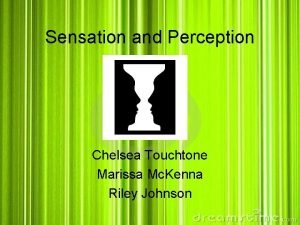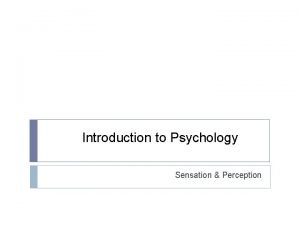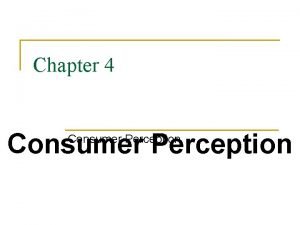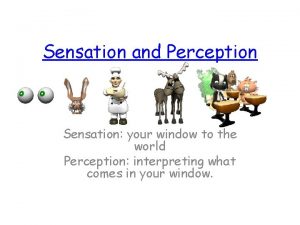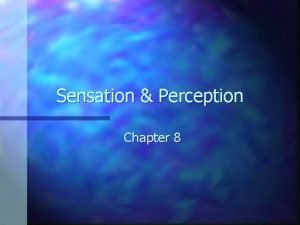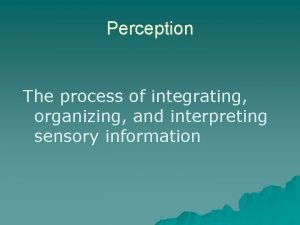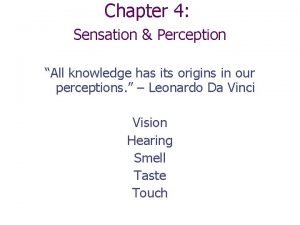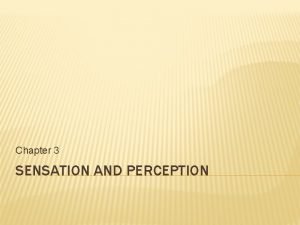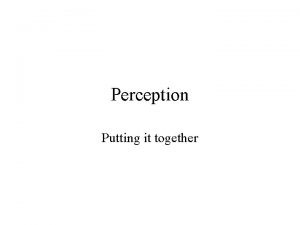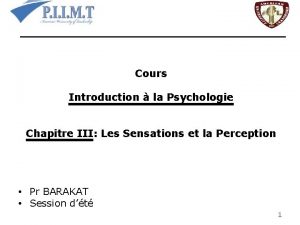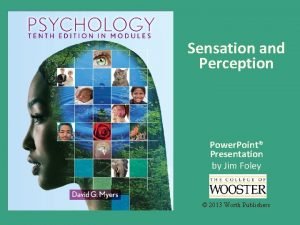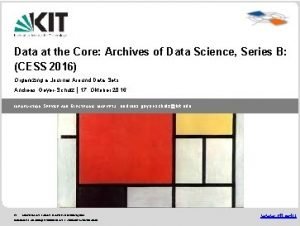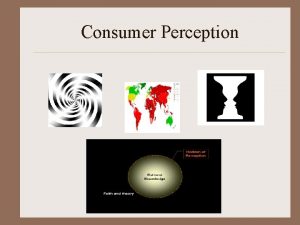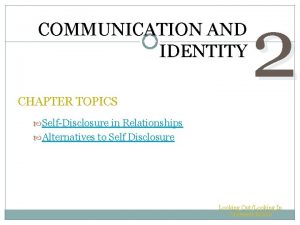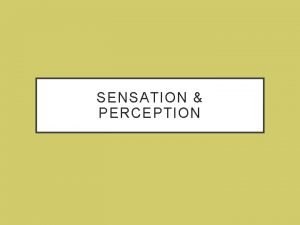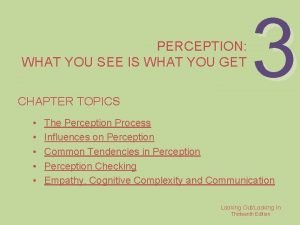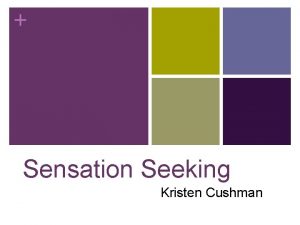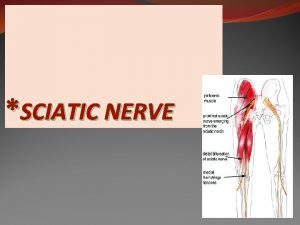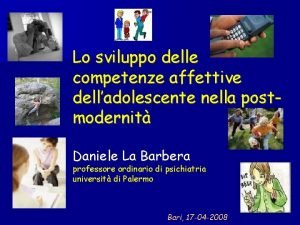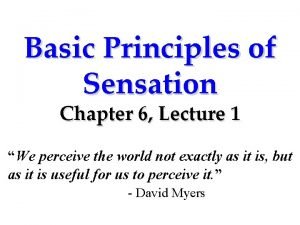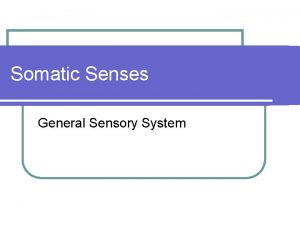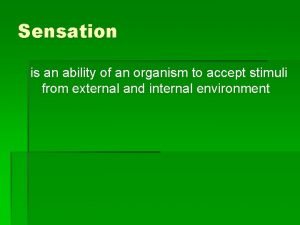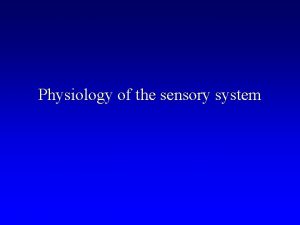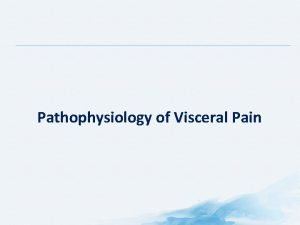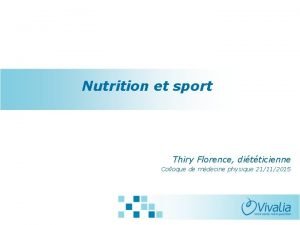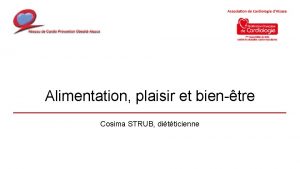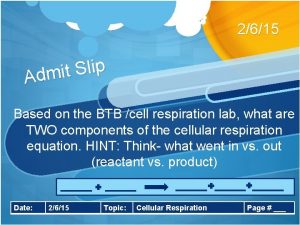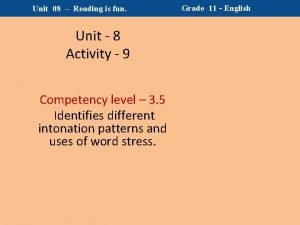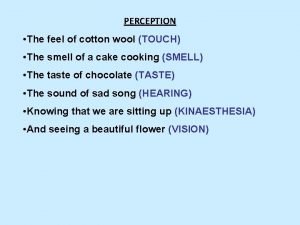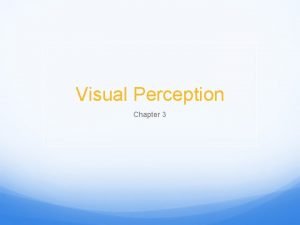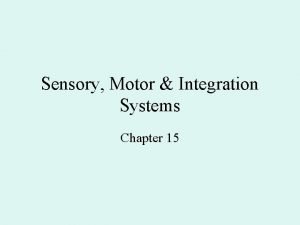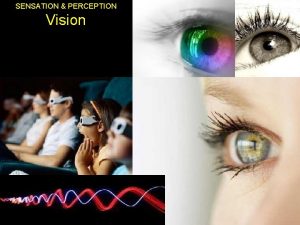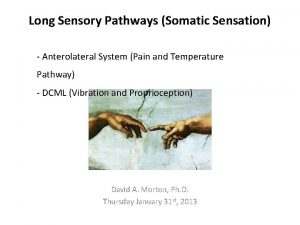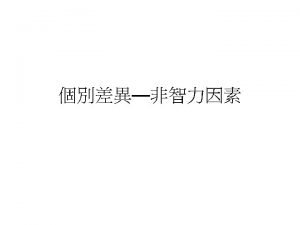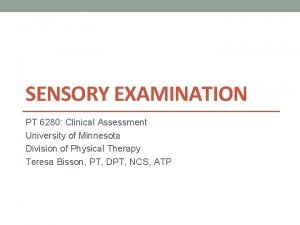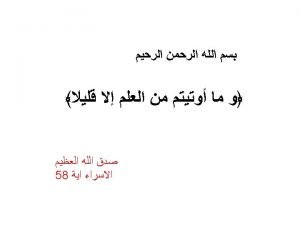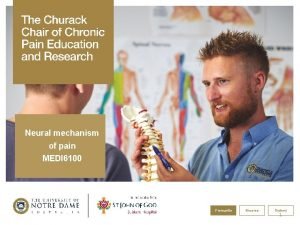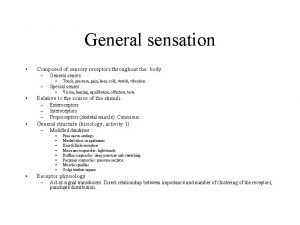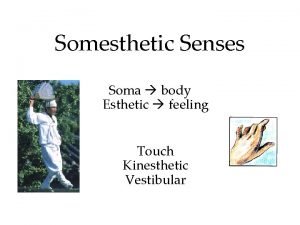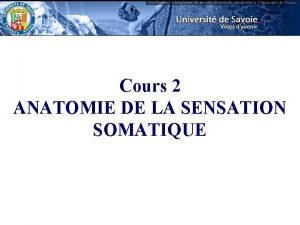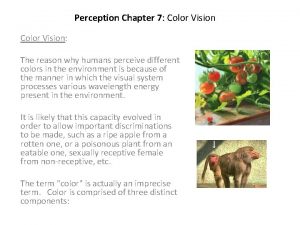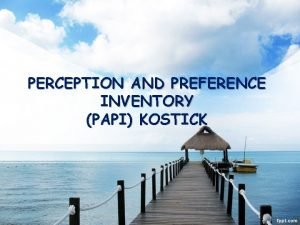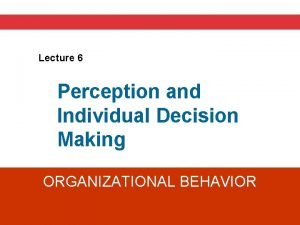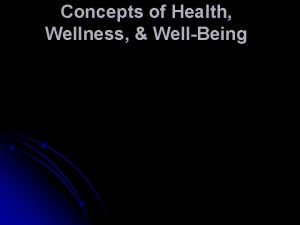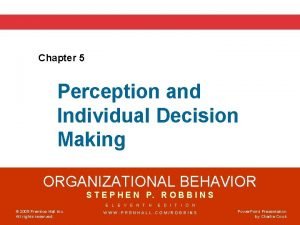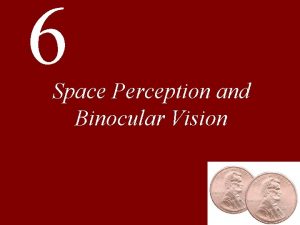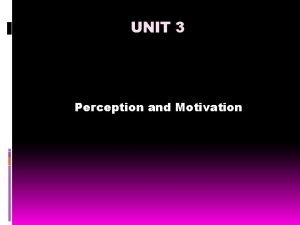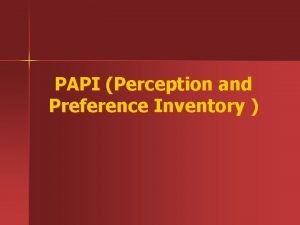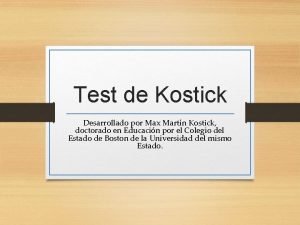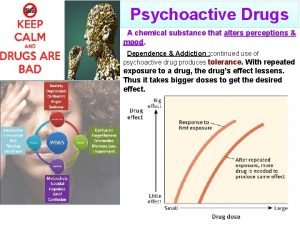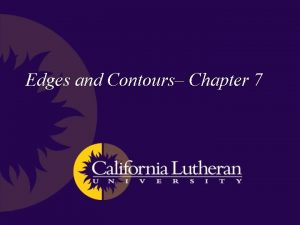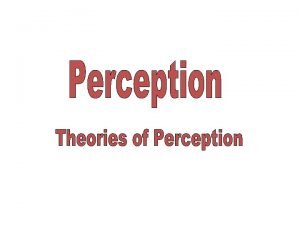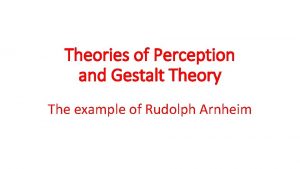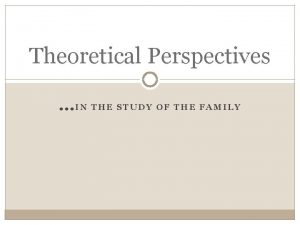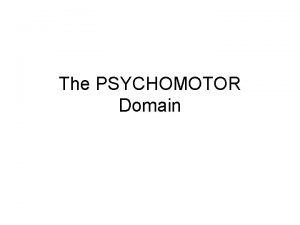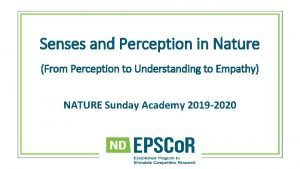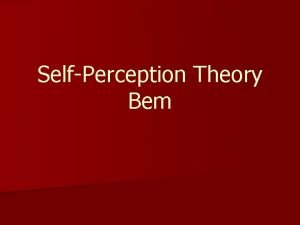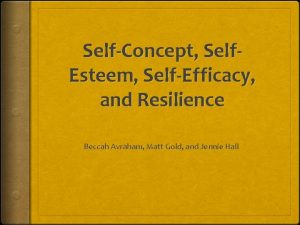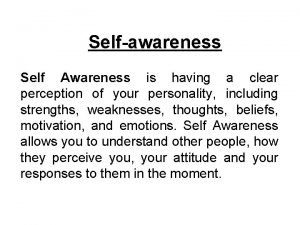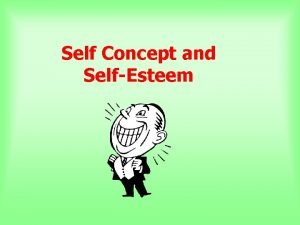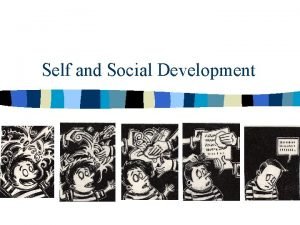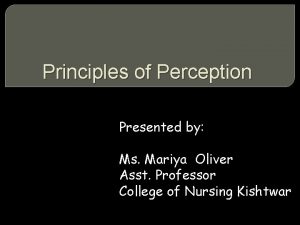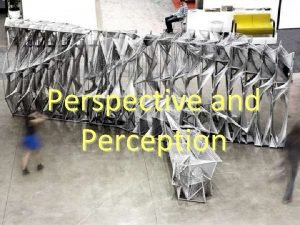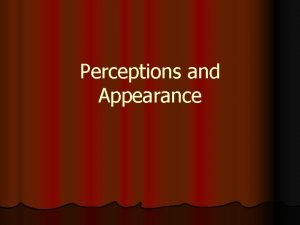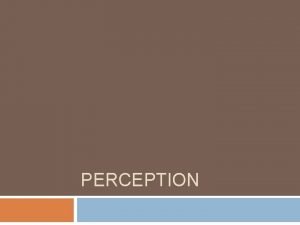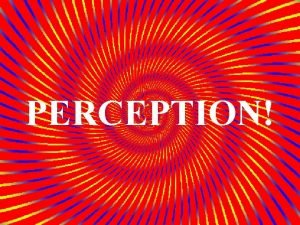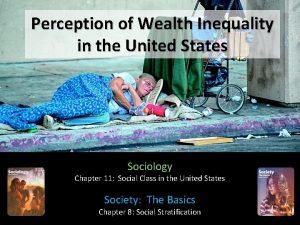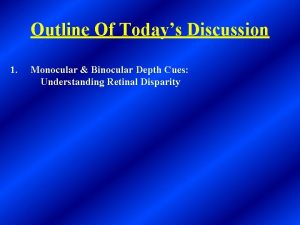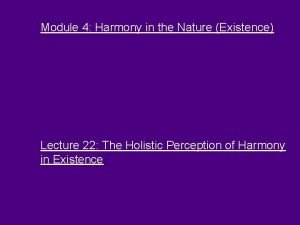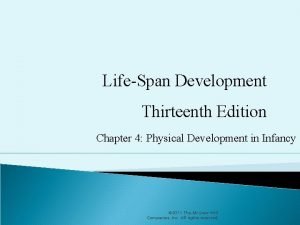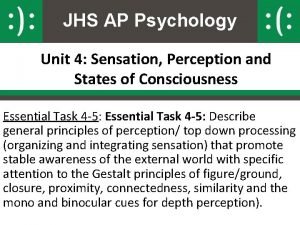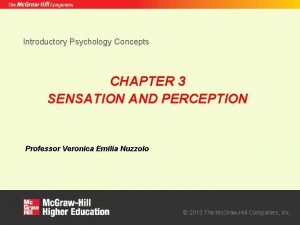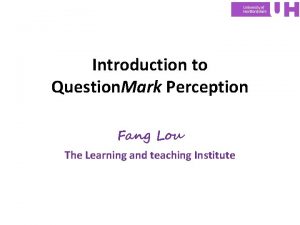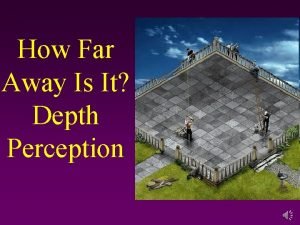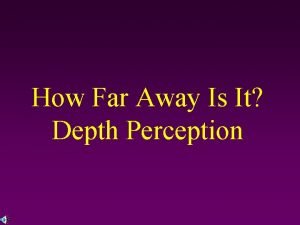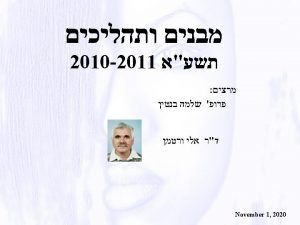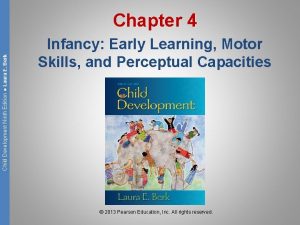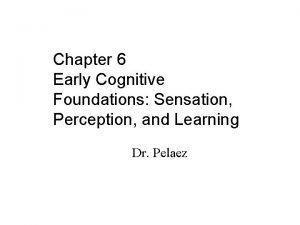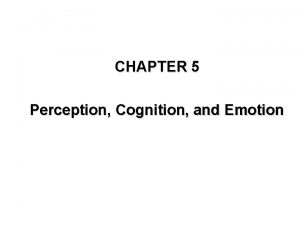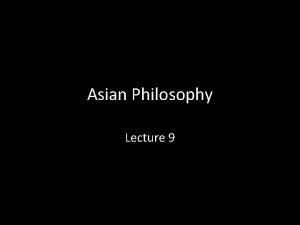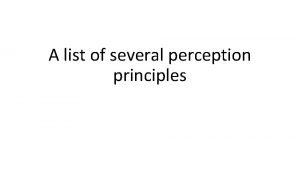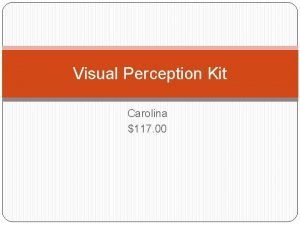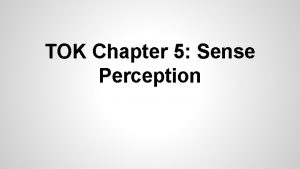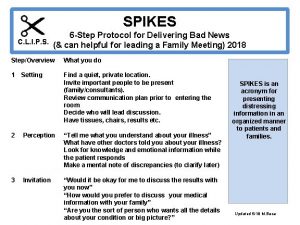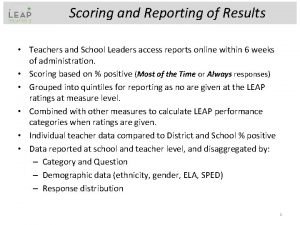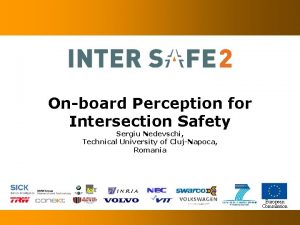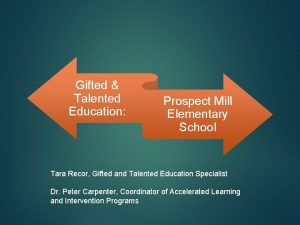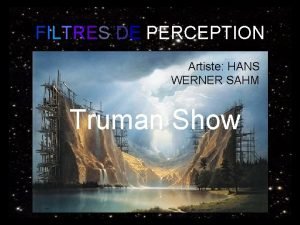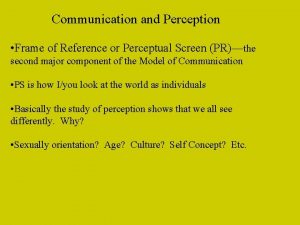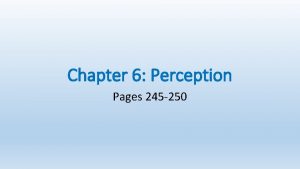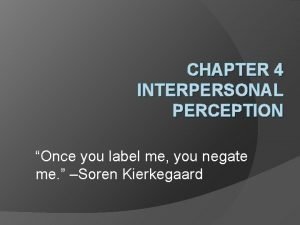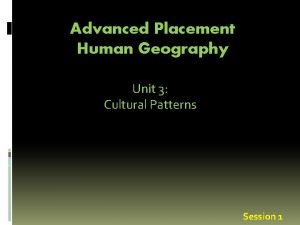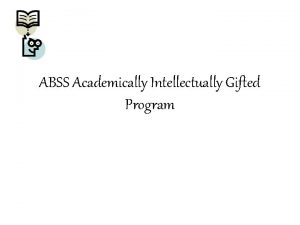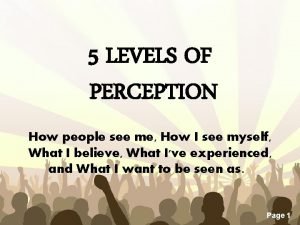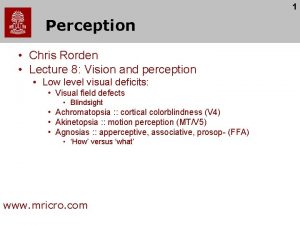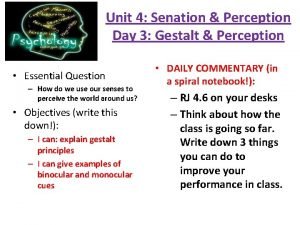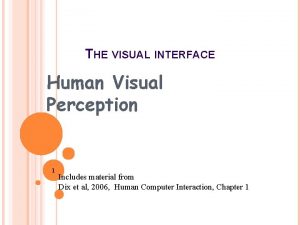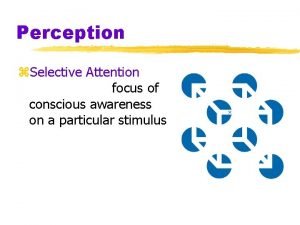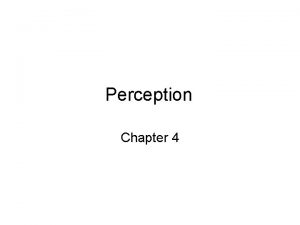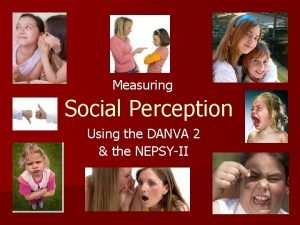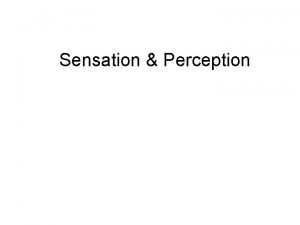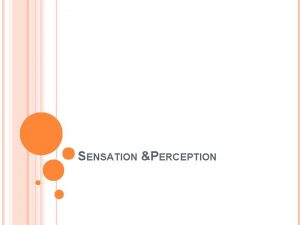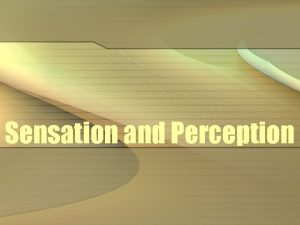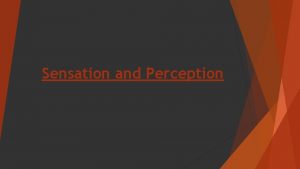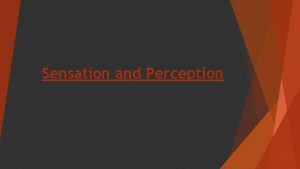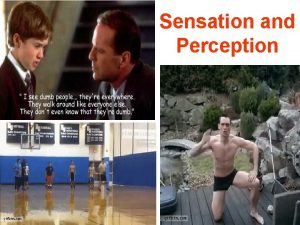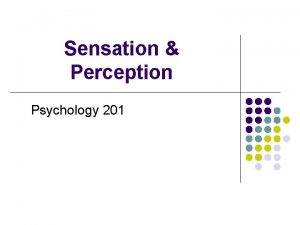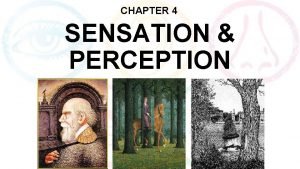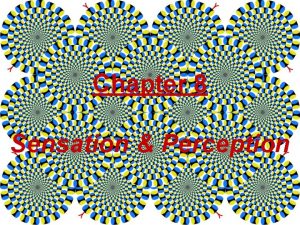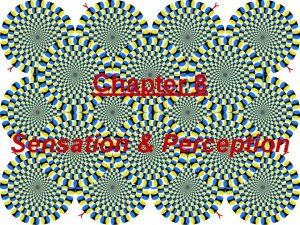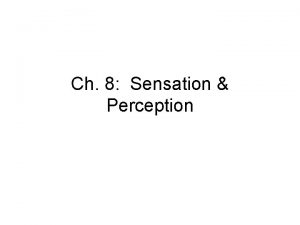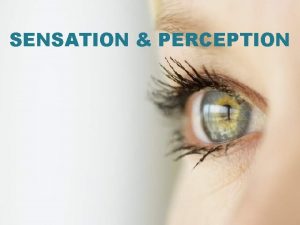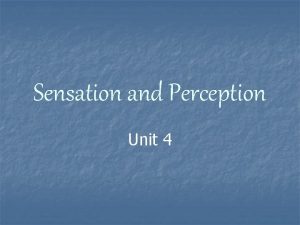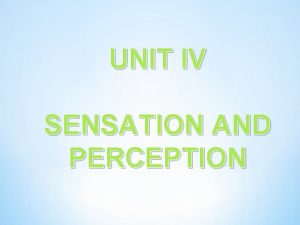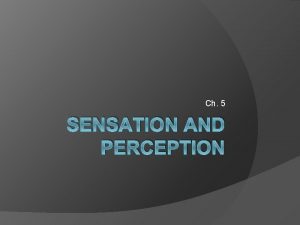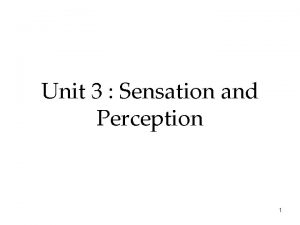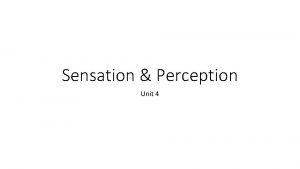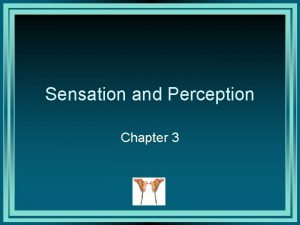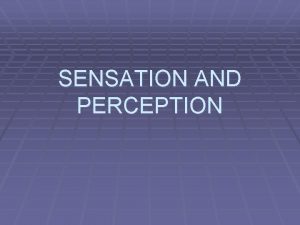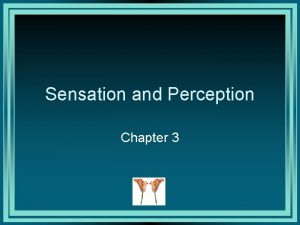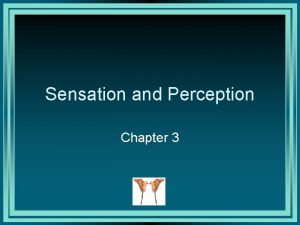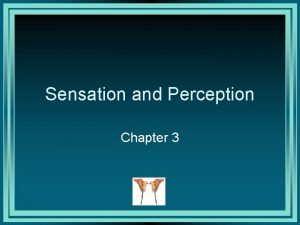Unit 4 Sensation and Perception Sensation a process

























































































































- Slides: 121

Unit 4: Sensation and Perception

Sensation *a process by which our sensory receptors and nervous system receive and represent stimulus energy Perception *a process of organizing and interpreting sensory information, enabling us to recognize meaningful objects and events

Sensation- Basic Principles Psychophysics *study of the relationship between physical characteristics of stimuli and our psychological experience of them *Light- brightness *Sound- volume *Pressure- weight *Taste- sweetness

Selective Attention n Selective Attention: when conscious attention focuses on a limited aspect of all you experience n Cocktail party effect: ones ability to attend to only one voice among many

Perception Selective Attention focus of conscious awareness on a particular stimulus …. means that at any moment we focus our awareness on only a limited aspect of all that we are capable of experiencing.

Selective Attention and Accidents n Cell phone use and car accidents

Testing Selective Attention

Selective Attention Selective Inattention n Inattentional blindness: if you aren't expecting to see something, you literally won't see it even if it's right in front of you.

Vision

Vision Transduction- conversion of one form of energy to another Wavelength- the distance from the peak of one wave to the peak of the next Hue- dimension of color determined by wavelength of light Intensity- amount of energy in a wave determined by amplitude n n brightness loudness

TRANSDUCTION: transformation of one form of energy into another-- especially the transformation of stimulus information into nerve signals by the sense organs. Without transduction, ripe tomatoes would not appear red (or pinkish gray--in the case of many tomatoes purchased in the grocery store).

Vision

Vision Accommodation --the process by which the eye’s lens changes shape to help focus near or far objects on the retina n n change in shape of lens focus near objects Retina --the light-sensitive inner surface of the eye, containing receptor rods and cones plus layers of neurons that begin the processing of visual information n n inner surface of eye light sensitive contains rods and cones layers of neurons beginning of visual information processing

Vision Acuity- the sharpness of vision Nearsightedness --condition in which nearby objects are seen more clearly than distant objects because distant objects in front of retina n nearby objects seen more clearly n lens focuses image of distant objects in front of retina Farsightedness --condition in which faraway objects are seen more clearly than near objects because the image of near objects is focused behind retina n faraway objects seen more clearly n lens focuses near objects behind retina

Visual Information Processing Parallel Processing n simultaneous processing of several dimensions through multiple pathways (color, motion, form, depth)


How the Brain Perceives

Illusory Contours Subjective Contours

Color Vision n Young-Helmholtz trichromatic (three color) theory n Red – Green - Blue n Monochromatic vision n Dichromatic vision COLOR DEFICIT VISION n People who suffer redgreen blindness have trouble perceiving the number within the design



Visual Information Processing Trichromatic (three color) Theory Young (1802) and Helmholtz (1850) n three different retinal color receptors n • red • green • blue You see colors according to their response to the wavelengths of light striking the retina---short-preferring (blue), middle-preferring (green), and long-preferring (red).

Visual Information Processing Opponent-Process Theory- opposing retinal processes enable color vision “ON” “OFF” red green red blue yellow blue black white black

Visual Information Processing Color Constancy Perceiving familiar objects as having consistent color, even if changing illumination alters the wavelengths reflected by the object

Perceptual Organization

Perceptual Organization- Gestalt Visual Capture § tendency for vision to dominate the other senses Gestalt--an organized whole § tendency to integrate pieces of information into meaningful wholes

Introduction n Gestalt (form or whole)

Escher

Escher

Perceptual Organization- Grouping Principles Gestalt grouping principles are at work here.

Perceptual Organization: Grouping Principles Impossible doghouse

Perceptual Organization Figure and Ground organization of the visual field into objects (figures) that stand out from their surroundings (ground)

Perceptual Organization § Figure and Ground--organization of the visual field into objects (figures) that stand out from their surroundings (ground)

Perceptual Organization- Gestalt Grouping § n n n the perceptual tendency to organize stimuli into coherent groups Grouping Principles proximity- group nearby figures together similarity- group figures that are similar continuity- perceive continuous patterns closure- fill in gaps connectedness- spots, lines and areas are seen as unit when connected

Form Perception Grouping - Proximity

Form Perception Grouping - Similarity

Form Perception Grouping - Continuity

Form Perception Grouping - Connectedness

Perceptual Organization- Grouping Principles


Perceptual Organization: Closure

Perceptual Organization-Depth Perception ability to see objects in three dimensions n allows us to judge distance n

Perceptual Organization. Depth Perception Babies develop depth perception at 3 months. Visual Cliff

Perceptual Organization Depth Perception Binocular cues n retinal disparity • images from the two eyes differ • closer the object, the larger the disparity n convergence • neuromuscular cue • two eyes move inward for near objects

Perceptual Organization-Depth Perception Monocular Cues n relative size • smaller image is more distant n relative height • higher objects seen as more distant n interposition • closer object blocks distant object n relative clarity • hazy object seen as more distant

Perceptual Organization-Depth Perception Relative Size

Depth Perception Mononocular Cues – Relative Size

Perceptual Organization: Depth Perception Relative Height

Line A – B is the same length as line C – D.

Depth Perception Mononocular Cues – Relative Height

Perceptual Organization-Depth Perception

Perceptual Organization: Depth Perception Interposition

Perceptual Illusions-Relative Clarity

Perceptual Illusions

Perceptual Organization-Depth Perception n Monocular Cues (cont. ) n relative motion • closer objects seem to move faster n linear perspective • parallel lines converge with distance n light and shadow • closer objects appear brighter n texture • Coarse close Fine distant

Perceptual Organization: Depth Perception Light and Shadow

Depth Perception Mononocular Cues – Linear Perspective

Perceptual Organization-Depth Perception Perspective Techniques

Depth Perception Mononocular Cues – Relative Motion

Insert You. Tube Phi Phenomenon

Perceptual Organization: Depth Perception Illusory Depth

Perceptual Organization: Depth Perception Photographer Walter Wick cut out pieces of paper shaped to imitate stair positions and colored them to iight and shadow. simulate

Perceptual Organization- Illusory Contours

Perceptual Constancy perceiving objects as unchanging despite changes in retinal image • color • shape • size

Perceptual Constancy Shape and Size Constancies n Shape constancy

Perceptual Organization Ponzo Illusion

Perceptual Organization-Muller. Lyer Illusion

Perceptual Illusions

Perceptual Organization. Brightness Contrast Perceptual Constancy: We know that the shadow doesn’t change the color of tile B to the same as tile A, even when it looks that way.

Perceptual Constancy Color Constancy n Color constancy n Surrounding objects context

Perceptual Organization. Brightness Contrast

Perceptual Illusions (AMES ROOM)

Perceptual Illusions

Perceptual Organization- Size. Distance Relationship

PERCEPTUAL ILLUSIONS

Perceptual Illusions

Perceptual Illusions

Perceptual Illusions



Picture or a word?



Illusions website http: //www. moillusions. com/ Julian Beevers sidewalk art http: //www. moillusions. com/2007/12/julian-beeversnew-3 d-sidewalk. html

Perceptual Interpretation

Sensory Deprivation and Restored Vision n Experiments on sensory deprivation n Critical period


Sensory Restriction. Blakemore & Cooper, 1970 Kittens raised without exposure to horizontal lines later had difficulty perceiving horizontal bars.

Perceptual Interpretation Perceptual Adaptation n (vision) ability to adjust to an artificially displaced visual field • prism glasses (displacement goggles) Perceptual Set n a mental predisposition to perceive one thing and not another

Perceptual Set. Schemas What you see in the center is influenced by perceptual set

Perceptual Set--Schemas Flying Saucers or Clouds?

Perceptual Set Context Effects n Context effects

Perception is a Biopsychosocial Phenomenon

The Stroop Effect (online) http: //www. njagyouth. org/colortest. htm

Perception and the Human Factors Psychology § § explores how people and machines interact explores how machine and physical environments can be adapted to human behaviors

Perceptual Set- Human Factors 10 Altitude (thousands of feet) Pilot’s perceived descent path 8 6 Altitude looks this much higher 4 2 0 Actual descent path 20 18 16 14 12 10 8 6 4 Distance from runway (miles) 2

Is There Extrasensory Perception?

Perception without Sensation? Extrasensory Perception n controversial claim that perception can occur apart from sensory input • telepathy • clairvoyance • precognition Parapsychology n the study of paranormal phenomena • ESP • psychokinesis

Parapsychology

GANZFELD EXPERIMENT (1930) Results present some of the strongest quantifiable evidence for paranormal phenomena to date. Very controversial Receiver is in state of sensory deprivation and yells out what he/she can see. Another person is given randomly choosen material and attempts to send the material telepathically to the receiver.

Premonitions or Pretensions? n Psychic predictions n Nostradamus

Putting ESP to Experimental Test n ESP n Experiments: predict the coin toss experiment using computer generated coin toss When ended in Jan 2000, 28 K people had predicted 110, 972 tosses with 49. 8% accuracy Richard Wiseman

QUESTIONS FOR REVIEW

1)RECALL The eyes have two distinct types of photoreceptors; the rods, which detect ______ and the cones, which detect ____. a) color/brightness b) low-intensity light/wavelengths corresponding to colors c) stimuli in consciousness/stimuli outside of consciousness d) bright light/dim light e) motion/shape

2) RECALL The wavelength of light causes sensations of _____, while the intensity of light causes sensations of ___. a) Depth/color b) Primary colors/secondary colors c) Color/brightness d) Bright light/dim light e) Motion/shape

3) RECALL The frequency theory best explains _____ sounds, while the place theory best explains ___. a) Tonal/atonal b) Simple/complex c) Low-pitched/high-pitched d) Loud/soft e) Pitch/timbre

4) RECALL Which sense make use of electromagnetic energy? a) hearing b) olfaction c) pain d) taste e) vision

5) SYNTHESIS What do all of these forms of sensation have in common: vision, hearing, taste, smell, hearing pain, equilibrium, and body position? a) They all involve waves having frequency and amplitude b) They all arise from stimulation that comes only from outside the body c) They all involve higher-order perception d) They all are conveyed to the brain in the form of nerve signals e) They all involve location of stimulation in threedimensional space.

6) UNDERSTANDING CORE CONCEPTS Different senses give us different sensations mainly because a) they activate different sensory regions of the brain. b) they have different intensities. c) they travel on different neural pathways. d) they involve different stimuli. e) we have different memories associated with them.

7) RECALL The sensory pathways carry information a) from the brain to the muscles. b) from the brain to the sense organs. c) from the central nervous system to the autonomic nervous system. d) from the muscles to the brain e) from the sense organs to the brain.

8) RECALL Which one refers to the least amount of stimulation that your perceptual system can detect about half the time? a) Fechner’s law. b) the absolute threshold c) the action threshold. d) the difference threshold e) the stimulus threshold.

9) RECALL Which of the following is a process that adds meaning to incoming information obtained by the sensory systems? a) detection. b) perception c) sensation. d) sensory threshold e) stimulation

10) APPLICATION Which one would involve sensory adaption? a) You no longer pay attention to the feel of the clothes on your body b) The flavor of a spicy salsa on your taco seems hot by comparison with the blandness of the sour cream c) The water in a swimming pool seems warmer after you have been in it for a while than it did when you first jumped in. d) You are unaware of a priming stimulus flashed on the screen at 1/100 of a second e) You prefer the feel of silk to the feel of velvet

11) UNDERSTANDING CORE CONCEPT When you hear the sound of a tree falling in the forest, the brain has received nothing but a) sound waves from the air b) the vibration of the eardrums. c) the sense of the air rushing by you. d) sound waves traveling through the sensory pathways. e) Neural activity in the sensory pathways.

1) RECALL Which of the following is an example of the kind of information that top-down processing contributes to perception? a) Looking for a friend’s face in a crowd b) Constructing an object from memory c) Hearing a painfully loud noise d) Feeling a pinprick e)having to wait for your eyes to adjust to the dark in a theatre.

2) RECALL The Gestalt theory proposes that many of our perceptions are determined by a) ambiguity b) bottom-up factors c) top-down factors d) illusions e) innate factors.

3) RECALL The faces/vase image illustrates a) closure b) attention as a gateway to consciousness c) figure and ground d) motion parallax e) similarity

4) APPLICATION When two close friends are talking, other people may not be able to follow their conversation because it has many gaps, which the friends can mentally fill in from their shared experience. Which Gestalt principle is illustrated by the friend’s ability to fill in these conversational gaps? a) Ambiguity b) Similarity c) closure d) common fate e) proximity

5) UNDERSTANDING CORE CONCEPT Which of the following best illustrates the idea that perception is not an exact internal copy of the world? a) the Ponzo illusion b) a bright light c) jumping in response to a pinprick d) bottom-up processing e) the sound of a familiar tune

5 paragraphs 1) Show MASTERS OF ILLUSION 3 monocular cues Brunelleschi *underline cue Massacio *define Donatello Albrecht Durer Michelangelo Erhard Schon Giotto Montegna Botticelli Holbein the Younger : Leonardo Da. Vinci Uccello Raphael Van Eck Piero Francesca *2 examples in art 2) Show DISCOVERING PSYCHOLOGY #7 Sensation & Perception Rubric: 1 st=10 pts, 2 -6=15 pts@, 7=15 pts

Now, on to PERCEPTION. . .
 Chapter 5 sensation and perception
Chapter 5 sensation and perception Gestalt principles of sensation and perception
Gestalt principles of sensation and perception Relative height ap psychology
Relative height ap psychology Sensation psychology
Sensation psychology Perception
Perception Chapter 3 sensation and perception
Chapter 3 sensation and perception Sensation and perception
Sensation and perception Chapter 6 sensation and perception
Chapter 6 sensation and perception Psychology chapter 4 sensation and perception
Psychology chapter 4 sensation and perception Perceptionn
Perceptionn Webers law
Webers law Sensation and perception
Sensation and perception Vestibular sense vs kinesthesis
Vestibular sense vs kinesthesis Chapter 8 sensation and perception
Chapter 8 sensation and perception Sensation and perception uu
Sensation and perception uu Chapter 4 sensation and perception
Chapter 4 sensation and perception What is sensation
What is sensation Sensation vs perception
Sensation vs perception Exposé sur la sensation en psychologie
Exposé sur la sensation en psychologie Perception vs sensation
Perception vs sensation Face recognition
Face recognition Perception checking process
Perception checking process Perception checking process
Perception checking process Process of perception
Process of perception Consumer perception process
Consumer perception process Pillow method communication
Pillow method communication Distal vs proximal
Distal vs proximal Pillow method communication
Pillow method communication The perception process
The perception process Unit process and unit operation
Unit process and unit operation Difference between unit process and unit operation
Difference between unit process and unit operation Unit 10, unit 10 review tests, unit 10 general test
Unit 10, unit 10 review tests, unit 10 general test Sensation seeking
Sensation seeking Sensory supply of sciatic nerve
Sensory supply of sciatic nerve Sensation seeking significato
Sensation seeking significato 6 principles of sensation
6 principles of sensation Types of sensation
Types of sensation Types of sensation
Types of sensation Classification of sensation
Classification of sensation Does muscle spasms cause burning sensation
Does muscle spasms cause burning sensation Ditticienne base sur coute sensation
Ditticienne base sur coute sensation Ditticienne base sur coute sensation
Ditticienne base sur coute sensation What causes the burning sensation in your muscles
What causes the burning sensation in your muscles Reading 08
Reading 08 Walking on cotton wool sensation
Walking on cotton wool sensation Sensation
Sensation Sensation
Sensation Opponent process theory vs trichromatic theory
Opponent process theory vs trichromatic theory Dcml sensation
Dcml sensation Thinking feeling intuition sensing
Thinking feeling intuition sensing Cortical sensations
Cortical sensations Crude touch
Crude touch Somatic pain pathway
Somatic pain pathway Ear sensory
Ear sensory Somesthetic senses
Somesthetic senses Sensation somatique
Sensation somatique Chapter 7 vision and perception
Chapter 7 vision and perception Tes papi
Tes papi Perception and individual decision making
Perception and individual decision making Eudemonistic model
Eudemonistic model What they see
What they see Subjective perception of vitality and feeling well
Subjective perception of vitality and feeling well Spatial sense in binocular vision
Spatial sense in binocular vision Motivation and perception
Motivation and perception Max martin kostick
Max martin kostick Test de kostick excel descargar
Test de kostick excel descargar A chemical substance that alters perceptions and mood
A chemical substance that alters perceptions and mood Chapter 7 managing risk vision and perception
Chapter 7 managing risk vision and perception Gregory top down theory of perception
Gregory top down theory of perception Gestalt in film
Gestalt in film Perspective vs perception
Perspective vs perception Perception in psychomotor domain
Perception in psychomotor domain Subjective time definition
Subjective time definition Nature of perception
Nature of perception Bem’s self-perception theory
Bem’s self-perception theory Self image vs self perception
Self image vs self perception Self awareness is having a clear perception of
Self awareness is having a clear perception of Self concept goals
Self concept goals Self image vs self perception
Self image vs self perception Principle of adaptability in perception
Principle of adaptability in perception Perspective quotes
Perspective quotes Interpersonal perception
Interpersonal perception What does the word perception mean
What does the word perception mean Perception is reality tattoo
Perception is reality tattoo Selective perception
Selective perception Questions on perception
Questions on perception Perception of wealth
Perception of wealth Binocular disparity
Binocular disparity Harmony in the nature and existence
Harmony in the nature and existence Rooting reflex
Rooting reflex Retinal disparity psychology
Retinal disparity psychology Perception meaning in psychology
Perception meaning in psychology Questionmark perception
Questionmark perception Monocular depth cues of interposition
Monocular depth cues of interposition Cues of depth perception
Cues of depth perception Categorical perception
Categorical perception Categorical perception psychology
Categorical perception psychology Intermodal perception
Intermodal perception Intermodal perception
Intermodal perception Intermodal perception
Intermodal perception Types perception
Types perception Perception in nyaya philosophy
Perception in nyaya philosophy Relative brightness example
Relative brightness example Carolina visual perception kit
Carolina visual perception kit Sense perception tok
Sense perception tok Spikes breaking bad news
Spikes breaking bad news Student perception survey dps
Student perception survey dps Levels of perception
Levels of perception Hcps gifted program
Hcps gifted program Mon filtre d'amour adrika
Mon filtre d'amour adrika Frame of reference communication
Frame of reference communication Monocular cues interposition
Monocular cues interposition Fundamental forces in interpersonal perception
Fundamental forces in interpersonal perception Artifact ap human geography examples
Artifact ap human geography examples Slocumb-payne scoring
Slocumb-payne scoring Levels of perception
Levels of perception Levels of perception
Levels of perception Perception gestalt principles
Perception gestalt principles Visual perception in hci
Visual perception in hci Perceptual perception
Perceptual perception Approaches to perception
Approaches to perception Danva score interpretation
Danva score interpretation




